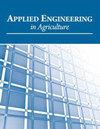NDVI在棉花变流量灌溉处方中的应用
IF 0.9
4区 农林科学
Q4 AGRICULTURAL ENGINEERING
引用次数: 1
摘要
highlightcrop系数(Kcb)采用归一化差异营养指数(NDVI)计算,并与FAO-56方法进行比较。比较了基于NDVI-Kcb灌溉调度与均匀支票簿灌溉调度的棉花产量。灌溉棉花产量在不同灌溉方式间无显著差异,但在需水量较大的年份显著较高。棉纤维品质在两种灌溉方式或植物种群间无显著差异。灌溉时机对实现棉花高产和棉质至关重要。这种灌溉时机在美国东南部沿海平原地区更具挑战性,因为其空间可变的沙质土壤在生长季节具有低水分和养分保持能力和降雨量变化。为了解决这些挑战,我们进行了一项为期2年(2017年和2018年)的研究,评估了可变速率灌溉系统下的两种灌溉调度方法。两种灌溉方式分别是:(1)基于作物周用水量的统一灌溉管理;(2)基于归一化植被指数(NDVI)的空间作物系数。比较了不同种植密度下两种灌溉方式的棉花产量和水分利用效率。两个植物种群分别为5和11.5植物m2,以提供不同的NDVI读数和需水量。2017年,由于生长季节降雨充足,只需要三次灌溉,棉花产量没有显著差异。NDVI法的平均灌溉深度显著低于均匀灌溉法(分别为56和64 mm, LSD = 4.2)。2018年生长季降雨量较低,需要8次灌溉,2个灌溉处理的棉花产量显著高于雨养处理。两种灌溉方式在2018年的灌溉深度差异不显著。两种灌溉方式的水分利用效率差异不显著。种植密度对棉花产量、灌溉深度、水分利用效率和棉纤维品质影响不大。这些结果表明,ndvi导出的作物系数值与灌溉管理的统一灌溉方法一样有效。ndvi衍生的作物系数灌溉方法似乎是管理灌溉和制定灌溉处方的有用工具。关键词:棉花;灌溉调度;归一化植被指数本文章由计算机程序翻译,如有差异,请以英文原文为准。
Using NDVI for Variable Rate Cotton Irrigation Prescriptions
HighlightsCrop coefficients (Kcb) were calculated using Normalized Difference Vegetative Indices (NDVI) and compared to the FAO-56 method.Cotton yields using NDVI-Kcb based irrigation scheduling to a uniform checkbook irrigation were compared.Irrigated cotton yields were not significantly different between irrigation methods but were significantly higher in years requiring higher volumes of irrigation water.Cotton fiber quality was not significantly different for the two irrigation methods or plant populations.Abstract. Irrigation timing is crucial for achieving high cotton yields and lint quality. This irrigation timing is more challenging in the southeastern U.S. Coastal Plain region due to its spatial variable sandy soils with low water and nutrient holding capacities and rainfall variability during the growing season. To address these challenges, we conducted a 2-year (2017 and 2018) study evaluating two irrigation scheduling methods under a variable rate irrigation system. The two irrigation methods were: (1) a uniform irrigation management based on weekly crop water usage, and (2) spatial crop coefficients derived from normalized difference vegetative indices (NDVI). We compared cotton yields and water use efficiency using the two irrigation scheduling methods at two different planting densities. The two plant populations were 5 and 11.5 plants m2 to provide different NDVI readings and water requirements. In 2017, there were no significant differences in cotton yields due to the adequate rainfall during the growing season that required only three irrigations events. The mean irrigation depth for the NDVI method was significantly lower than the uniform method (56 and 64 mm, respectively, LSD = 4.2). In 2018, there was lower rainfall during the growing season requiring eight irrigation events and the cotton yields in the two irrigation treatments were significantly higher than the rainfed treatment. Irrigation depths in 2018 were not significantly different for the two irrigation methods. Water use efficiencies were not significantly different for the two irrigation methods. The planting density had little impact on the cotton yields, irrigation depth, water use efficiency, or cotton fiber quality. These results indicate that the NDVI-derived crop coefficient values were as effective in prescribing irrigation applications as the uniform irrigation method for irrigation management. The NDVI-derived crop coefficient irrigation method appears to be a useful tool for managing irrigation and developing irrigation prescriptions. Keywords: Cotton, Irrigation scheduling, Normalized difference vegetation indices, Variable rate irrigation
求助全文
通过发布文献求助,成功后即可免费获取论文全文。
去求助
来源期刊

Applied Engineering in Agriculture
农林科学-农业工程
CiteScore
1.80
自引率
11.10%
发文量
69
审稿时长
6 months
期刊介绍:
This peer-reviewed journal publishes applications of engineering and technology research that address agricultural, food, and biological systems problems. Submissions must include results of practical experiences, tests, or trials presented in a manner and style that will allow easy adaptation by others; results of reviews or studies of installations or applications with substantially new or significant information not readily available in other refereed publications; or a description of successful methods of techniques of education, outreach, or technology transfer.
 求助内容:
求助内容: 应助结果提醒方式:
应助结果提醒方式:


